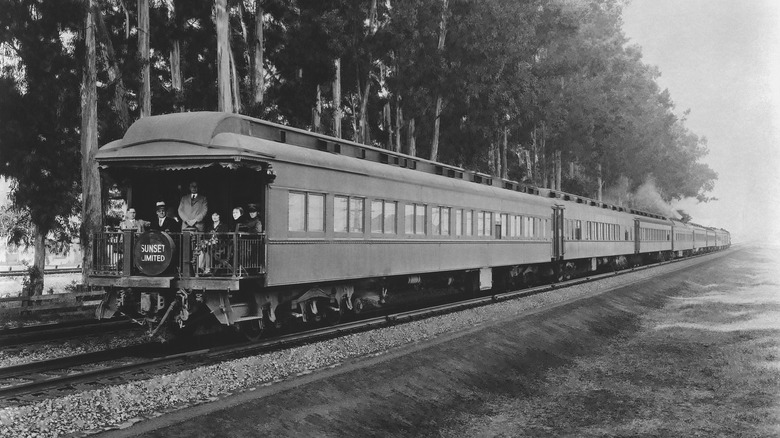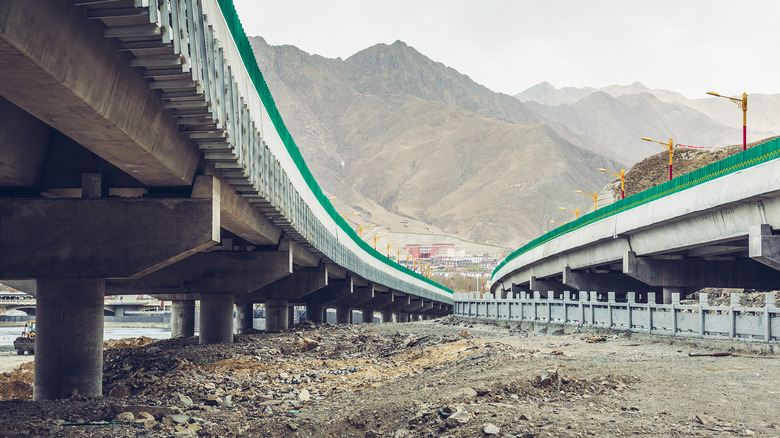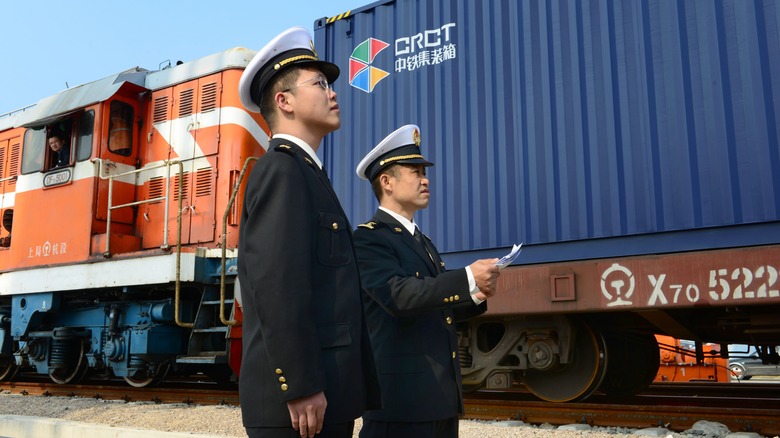The Longest Train Lines In The World, Ranked By Length
The world's first public railway was the Stockton to Darlington line in England, which opened in 1825. It was just eight miles long when it opened to transport both passengers and freight. Developed at the height of the Industrial Revolution, the railway went on to become a crucial worldwide mode of transportation, not only revolutionizing industry but also travel and trade.
Many classic locomotives from that period survive today, but as technology has advanced, railways have expanded across continents, connecting cities and countries. They played a vital role in economic growth, facilitating trade, and shaping urban development. This led to a vast global network of railway lines that were transporting heavy goods, fuel, and travelers far and wide.
However, the rise of automobiles and airplanes in the 20th century meant passenger numbers declined and rail lines were abandoned. Efforts were made to modernize rail infrastructure through the introduction of faster trains. Today, bullet trains in Japan and China are setting world speed records while transporting passengers across considerable distances in times that rival, and in some cases even exceed air travel after you factor in airport procedures. There's even talk of hydrogen trains becoming the green future of rail travel.
In contrast, other trains have become luxurious tourist attractions and have managed to stay in operation thanks to the dollars that travelers are willing to spend to traverse such iconic and expansive routes. However, the network of rail lines has become so complex that it can be difficult to know where one track ends and another begins. So, after some lengthy deliberation and research, here are the world's longest rail lines.
10. Adelaide to Darwin, 1,851 miles (2,979 km)
The Ghan is a tourist passenger train that traverses the second-longest railway line in Australia. It operates between the southern city of Adelaide and its northern counterpart Darwin, which are a considerable 1,851 miles of track apart. The Ghan is an abbreviated form of The Afghan, which is a nod to the contributions of the Afghan camel drivers whose explorations of the Australian interior later facilitated railway development.
It's an extremely long train, with its 24 carriages and two NR class diesel-electric locomotives adding up to almost a half mile. In fact, it's so long that the boarding process takes place over two platforms. The train rumbles up and down the country at an average speed of 53 mph, and the whole journey takes around 54 hours. Scheduled stops take place along the way to take in the sights of the country's Red Center.
However, as reported by The Guardian in 2009, one of these stops resulted in an American tourist having to cling to the exterior of the train for two hours as it rolled through the freezing desert. He had returned to the train as it was pulling away from the station and frantically clambered aboard in the hope that passengers would let him in when he banged on the window of the Platinum-Class dining car. However, they ignored his calls for help for over two hours until a crew member finally realized and stopped the train. The then 19-year-old Chad Vance narrowly escaped hypothermia or a fatal fall.
9. New Orleans to Los Angeles, 1,995 miles (3,212 km)
The line between New Orleans and Los Angeles consists of an impressive 1,995 miles of track. The Sunset Limited, a long-distance passenger train once operated by Southern Pacific Railroad and now run by Amtrak, has plied this route since 1894. It is scheduled three times weekly in either direction and is the oldest continuously operating named train in North America.
Two GE P42DC diesel locomotives pull the cars along the track with 4,200 hp of force at a top speed of 79 mph. Journey time takes around 48 hours, and the train passes through five states, Louisiana, Texas, New Mexico, Arizona, and California, with a total of 21 stops. The train employs Superliner Rail Cars, which have two levels. Seating is on the upper level for fine views, and there's also an observation car where passengers can take in the wetland, swamp, and desert landscapes.
However, with such a long time of operation, the Sunset Limited has no doubt been involved in collisions. The most infamous of which occurred in 1993 when a towboat collided with the Bayou Canot Railroad Bridge and displaced a girder. The Sunset Limited attempted to pass over moments later and was derailed. This tragically led to the deaths of 47 passengers, with many more seriously injured.ddd
8. Chicago to Emeryville, 2,438 miles (3,924 km)
The California Zephyr has been in operation since 1949. It initially operated from Chicago to Oakland but now traverses the 2,438 mile route from Chicago to Emeryville. It is one of the USA's most iconic trains and was rescheduled by Amtrak in 1983 after discontinuation in '69 when air travel poached many of rail travel's passengers.
Two GE Genesis/Siemens ALC-42 locomotives pull the cars along this line at an average speed of 55mph with a top speed of 79mph. It passes through much of America's most stunning scenery that passengers can view from the bi-level Sightseer-Lounge car with its panoramic windows and comfortable seats. Over the course of two days and three nights, travelers can marvel at the route's undoubted highlights — the stunning mountain vistas of the Rockies and Sierra Nevada. Amtrak specifically chose a schedule that allowed the train to pass by the line's most breathtaking views during daylight hours.
However, the train's route also incorporates historically significant sites, such as the Donner Pass in California. This was the scene of the grim Donner Party winter incident of 1846, where a group of lost pioneers reportedly resorted to cannibalism in order to survive. The train also traverses under the Rockies through the 6.2 mile Moffat Tunnel in Colorado at the line's highest point of 9,270 feet.
7. Sydney to Perth, 2,704 miles (4,352 km)
In 1969, the Australian government and state rail authorities completed an uninterrupted rail link from the Pacific to the Indian Ocean. The Indian Pacific passenger train made the country's first transcontinental journey from Sydney to Perth in early 1970. It came after more than 50 years of railway construction, and a crowd of over 10,000 citizens came out to welcome the train on its inaugural arrival in Perth. The 2,704 mile line takes three full days to traverse and claims the unique distinction of featuring the world's longest section of straight track. It runs for 478km without even a slight curve between Ooldea in South Australia and Loongana in the west.
Two diesel/electric locomotives pull an average of 35 cars along the continent-traversing track at an average speed of 53 mph with a top speed of 71 mph. The lead locomotive boasts a GE 7FDL16 powerplant that produces up to 4,020 hp to drag the cars through a variety of landscapes from the Blue Mountains outside Sydney to the vast, unearthly stretches of the Nullarbor Plain.
The coast-to-coast journey takes place twice a week in either direction and is primarily a ride for tourists. Passengers can enjoy a variety of cabin classes and even have opportunities to step off the train to explore some remote areas. The train even took part in the passing of the Olympic Flame prior to the Sydney 2000 games when it carried the torch across the Nullarbor Plain.
6. Shanghai to Lhasa, 2717 miles (4,374km)
The Z164 is one of China's Z-series trains and operates on the Shanghai to Lhasa route. These trains are not the high-speed bullets the country is renowned for, as even the longest HSR line in China is too short to make this list.
However, the Z164 covers an incredible 2,717 miles from the futuristic city of Shanghai to the historic sites of Lhasa in Tibet. However, these trains are not known for their luxury and are not aimed specifically at tourists. Passengers can choose from a variety of classes, from a comfortable soft-sleeper bed in a compartment you share with three others to a not-recommended hard-seat option. The journey takes precisely 44 hours and 33 minutes — Chinese trains are renowned for their punctuality – and passengers spend two nights sleeping on the train.
However, getting a good night's rest may be a problem for some as the rail line gains over 16,600 feet in elevation once it is up on the Tibetan Plateau. In fact, once you are past Xining, you are officially on the highest railway line in the world. Many people suffer from mild altitude sickness symptoms. However, the Shanghai-Lhasa Train is sealed and pressurized, with both automatic and manual oxygen supplies to help manage symptoms. It is all worth it because you do pass through some incredible landscapes of snowy mountains and frigid grasslands and even go through the world's highest railway tunnel, the Fenghuoshan.
5. Chicago to Los Angeles, 2,728-mile (4,390 km)
The Texas Eagle is another long-distance Amtrak passenger train that makes this list. It operates daily between Chicago and San Antonio, but three times per week it joins the Sunset Limited to continue on to Los Angeles. This makes it the longest train route in the United States at 2,728 miles. The whole journey takes over 65 hours, with three full sleeps on the train. There are 43 stations on the route in total, and the train features two-level Superliner cars and an observation deck where passengers can admire the picturesque views of the Ozark Mountains and the lush greenery of Arkansas.
Originally, the Texas Eagle ran between St. Louis and various cities in Texas when it was part of the Missouri Pacific Railroad (MoPac) network. The train made its debut way back in 1948 and was a member of a team of Eagles that plied the country with St. Louis as its hub. By 1971, Amtrak had taken over operations, and the train was discontinued. However, in 1981, the Texas Eagle was reborn and it was in this year it joined the Sunset Limited in San Antonio to continue its long journey all the way to California without passengers needing a change of train.
4. Toronto to Vancouver, 2,775 miles (4,466 km)
The Toronto to Vancouver route is the longest rail line in North America and is famously plied by the luxury transcontinental passenger train The Canadian. The line, long called the Canadian Pacific Railway, was completed in 1885 and linked the east and west of the country by rail for the first time. With dangerous working and substandard living conditions, hundreds of laborers from China who were imported to work on the railway perished in accidents or from poor health. However, many of the thousands who lived to see the railroad completed were able to form the foundations of Canada's sizeable Chinese community.
At 2,775 miles in length, the construction was clearly no easy task. Even today, it remains one of the longest in the world, and the Canadian passenger train is the ideal way for tourists and locals to get an idea of the country's railway history while taking in some of its most stunning sites. The Canadian passes through endless wonders, such as the Rocky Mountains, with breathtaking views of forests, lakes, plains, and rugged peaks. The entire journey requires four full sleeps on the train, and takes a whopping 86 hours to complete the journey.
3. Moscow to Beijing (via Harbin), 5,582 miles (8,986 km)
The Trans-Manchurian Railway spans almost the entire country of Russia before crossing the border of China at Zabaikalsk. From there, the track ventures southeast to the frozen city of Harbin before switching southwest to Beijing for a total of 5,623 miles. This route is one of two from Moscow to Beijing. The Trans-Mongolian Railway connects the same two cities but does so via Ulaanbaatar, Mongolia. This line is 4,735 miles (7,622 km) in length. However, those wishing to go the extra mile (or the additional 888, to be precise) can do so while cutting out the need for a Mongolian visa.
The Vostok train is the one to take if you want to get all the way from capital city to capital city without changing trains. It departs Moscow's Yaroslavsky station around midnight twice a week and arrives in Beijing some 146 hours and seven time zones later. Tourists can use this line to take in the sights of Russia and China — or Mongolia, if they decide to switch trains. They can jump off at cities like Irkutsk to marvel at Lake Baikal, the world's largest freshwater lake. At Harbin, they can witness the world's most impressive ice and snow festival and stare in bewilderment at vast ice palaces, pandas, and Buddhas, all lit up in a kaleidoscope of color at night.
2. Moscow to Vladivostok, 5,771 miles (9,289 km)
The line that spans the entire terrain of Russia is known as the Trans-Siberian Railway or the Great Siberian Route. The Trans-Siberian Express is the train that rides this 5,771-mile (9,289-km) track, which makes it the longest passenger train ride in the world. The Rossiya departs Moscow's Yaroslavsky station 35 minutes after midnight and sets on its long journey across two continents and eight time zones with around 100 stops in various cities. It terminates in Vladivostok some 174 hours (or seven days) later and crosses some of the country's bleakest, most frozen landscapes on top of evergreen forests, rugged peaks, and raging rivers.
Work on the railway began in 1891 with the purpose of expanding Russia's influence into East Asia and toppling British trade dominance. The line initially bypassed Siberia due to the harsh conditions of the region. Instead, it made inroads into Manchuria, much to the dismay of the Chinese. In fact, it alarmed the Japanese so much that it contributed to tensions that sparked the 1904-05 Russo-Japanese War.
Following the conflict, the Russians found a way to complete the line within its own borders. It was finished in 1916 and played significant roles in several historical events. Among these is the Russian Civil War, where anti-communist forces (backed by Canadian reinforcements) used the line to push westwards toward Moscow. The Nazis briefly also used this railway to transport goods between Germany and Japan, while many Jewish people used the route to escape persecution and set sail for the United States at the end of the line. It's even possible that Vladimir Putin himself has traveled this line in his infamous Ghost Train.
1. Yiwu to Madrid, 8,110 miles (13,052 km)
Yiwu has the odd nickname of The World's Capital of Small Commodities and is a major hub of trade between China and the rest of the world. So much so that the city has become an integral part of the Chinese Communist Party's Belt and Road Initiative. This is a government strategy that aims to better link the country with Africa and Europe through land and sea routes with the purpose of boosting trade and economic growth.
In 2014, the Yiwu to Madrid railway track completed its inaugural journey. However, it's no passenger train that traverses this track. You won't find any first or second-class cabins. There's no dining cart or air conditioning, and if you did somehow find yourself onboard this train, you'd have to sit on your luggage. This is a freight train that passes through Kazakhstan, Russia, Belarus, Poland, Germany, and France before finally arriving in Madrid some 8,110 miles (13,052 km) and 21 days later. It is one of several Sino-Euro freight railways, but the Yiwu to Madrid line is easily the longest.
The trains transport a diverse range of goods, from laptops to food, more quickly and more cheaply than ship or flight can, and it looks very much to be a permanent fixture of trade between East and West.










